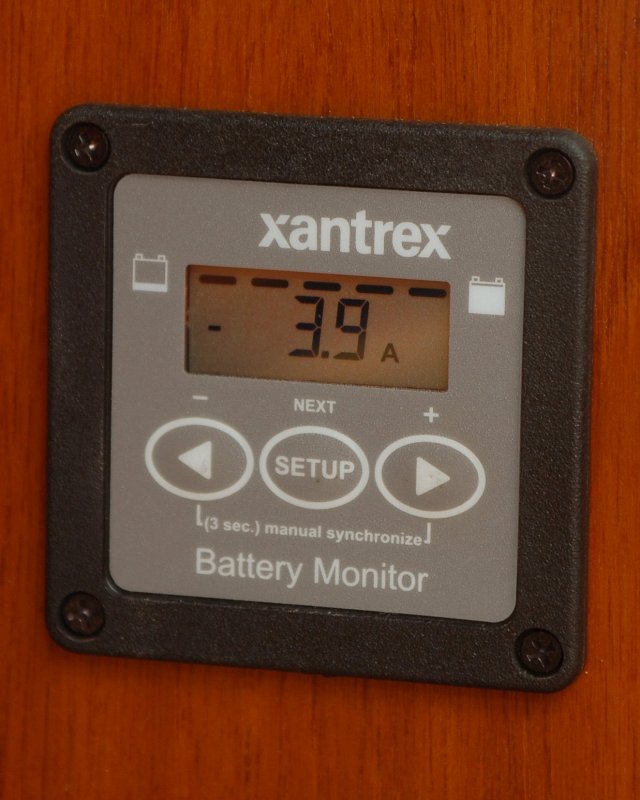Quote:
Originally Posted by noelex 77

The equipment you used is not capable of measuring the inrush current. The time frame is too small. In the kink I posted you can see after the initial 1200A inrush current a much lower current, consistent with your results, is measured.
.
|
And you know this how?

From the owners manual:
"Peak Hold
The Peak Hold function captures the peak AC or DC voltage or current. The meter can capture negative or positive peaks as fast as 1 millisecond in duration."
There are a fair number of meters out there that can capture DC in-rush but you need to read the lit to be sure. The Fluke's, like the 337 or 376, are 100ms which is still plenty fast enough, and the Extech's are 1 ms (1/1000th of a second) capture speed.
Quote:
|
Originally Posted by Blue Seas
When starting the engine there is a large current spike of approximately ¼ second duration required to begin the rotation of the engine. This phase of engine starting is called the Inrush Period. Once the engine is rotating, but before it starts there is another period averaging 9-3/4 seconds, called the Cranking Period. These two Periods combine to make the Engine Cranking Cycle.
|
If you are concerned about the speed of the instrument I used I would simply argue, IMO, it just does not really matter if it spikes over my measured reading of 120-180 amps for anything less than 1/1000th of a second.

Considering Blue Seas states .25 seconds and my meter captures to .001 seconds then I suspect it is capturing in-rush well, unless I have been mislead by the manufacturer..

We also do not know what engine Blue Seas used to get that data. In all likely
hood, to make their point about battery switches, it was a very large diesel on a Sport
Fisher not a 44HP diesel with a stated CCA draw of just 160 amps. My video obviously does not apply to an 800 HP Man or Caterpillar as it is a small 44 HP diesel.
The 44B Four engine has a stated cold cranking amp draw of 160 amps @ 79 degrees. Here's a link that shows it:
LINK
Westerbeke wants to see a battery for my engine with at least a 600 CCA rating. This is not a large CCA rating for a 44 HP diesel.
Just one
single group 27 West Marine/Deka deep cycle has 575 CCA and a Group 27/SCS200 Trojan Deep Cycle has 620 CCA. Who really has a
single battery bank for house loads of just one group 27 that also has a diesel engine and actually cruises their
boat?? Just two WM grp 27's can supply 1150 CCA & 1430 MCA.
Even two Sea Volt/WM/Deka 6V batteries in series will give you 975 MCA or well over the necessary 600 CCA for our 44 HP.
CCA ratings for a more popular engine such as the Universal M-25, M-35 or M-40 are for at least a 400 CCA rated battery. Most any good group 24 deep cycle battery will easily exceed 400 CCA. Heck they make personal watercraft batteries with 500 CCA these days. The WM/Deka group 24 Deep Cycle is 500 CCA for just a single battery and is actually 100 CCA over what is necessary for an M-25 - M-40 per the manufacturers specs.
On our 44 HP engine I have measured it as high as 180 and as low as 120 peak/in-rush and this is a meter than can do 1/1000 of a second captures.
Considering I have been starting small sailboat aux engines, and mid sized diesels on deep cycle batts for well over 20 years, and never once had an issue, and have measured the starting loads as best I can with products designed to do so, I suspect these "peaks" of .25 seconds or less really don't matter much in the whole scheme of things.
When you parallel banks, and they get bigger, you combine the amps, which includes the cranking amps. Most
small boat sailors (sub 45 feet), even with deep cycle batts, have a lot more CA available in the house bank than the single small group 24 or 27 starter battery they have they just have not yet figured that out.
If you compare the WM pure starting battery ratings to the WM deep cycle batt you get:
WM Grp 27 Deep Cycle = 715 MCA
vs.
WM Grp 27 Starter = 925 MCA
This is only a 210 CA difference from a true deep cycle to a starter battery.
Combine the two deep cycle batts into one house bank and you now have approx 1430 MCA vs. 925 MCA for the single starter bank....
All engines are slightly different and the peak draws will be too, some higher and some possibly lower. But most house banks, even when deep cycle, will start a small
marine aux diesel with no issues. My point is still the same that a sufficient house bank of deep cycle batts should easily start most any small aux diesel engine the bank has been properly cared for.











 I am simply trying to prevent any more fried diodes with this video!
I am simply trying to prevent any more fried diodes with this video! . Hopefully this video will give some of you piece of mind around the subject of starting and how little it actually consumes.
. Hopefully this video will give some of you piece of mind around the subject of starting and how little it actually consumes. 


 Still, it's not the load most think it is!
Still, it's not the load most think it is!





 Linear Mode
Linear Mode




 Recent Discussions
Recent Discussions